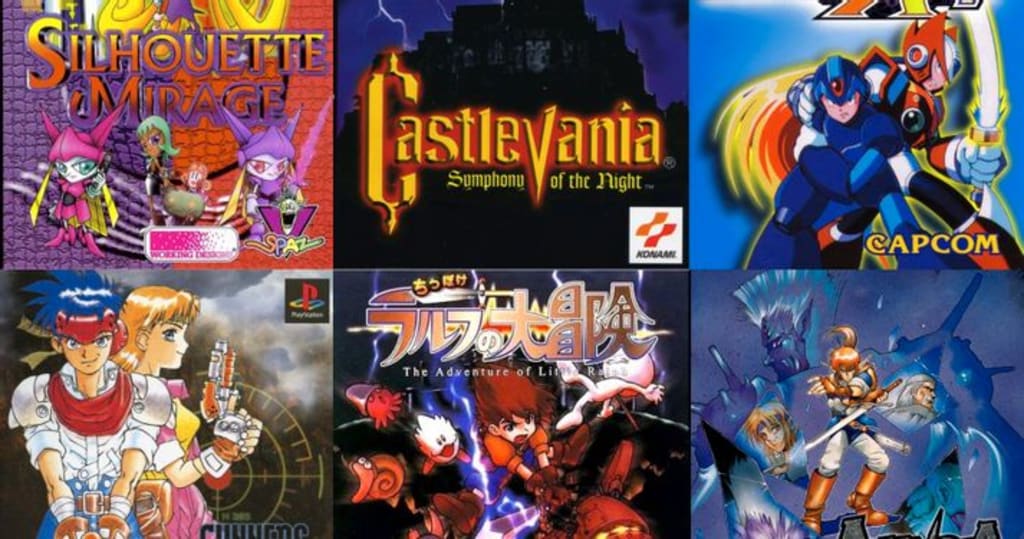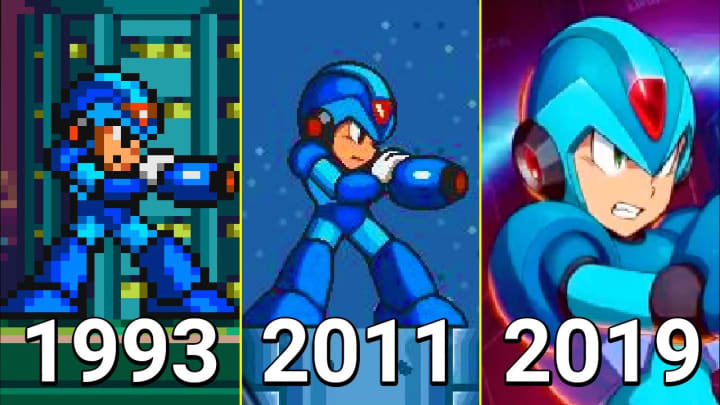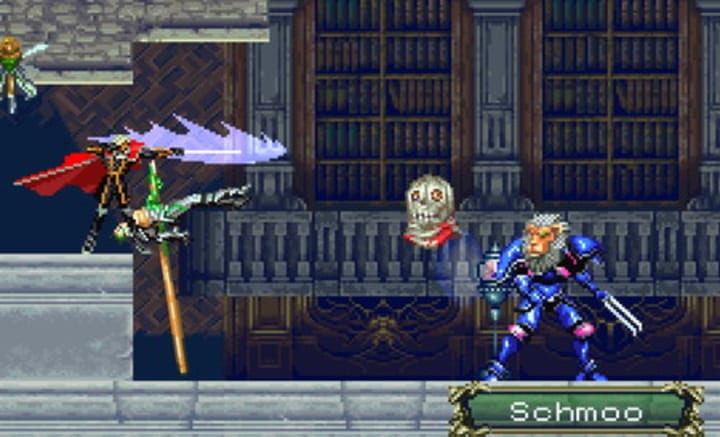What happened to 2D games in the 32-bit console generation?
I think there is no more ironic and misunderstood era than the era of 32-bit pixel art games. We have heard thousands of times the term 8-bit or 16-bit, but what about the hundreds of games that came out after these? that were still pixel art these games that are automatically related to retro games (even if they are released today) have these names to simply classify them easily, although this is somewhat incorrect because the pixel art has never been made from these terms but has been a sales tool since the late 80s onwards but today they still work like this to identify all games.

And if you are reading this because of the title then it is proof that we still think the same way we did some years ago.
When we mention this term 32 bits is not something as common as the others, sometimes we mistakenly say 8 bits is from NES and 16 bits is from Super Nintendo on the other hand to say simply 32 bits is something confusing, first of all because if you search this term in Google that is interpreted to games and software that compute under an operating system of that number and not to pixel art games, so yes, if you look for it you are not going to find an answer.

The 32-bit games were the natural evolution, taking Mega Man X as an example, its first three games were 16-bit style and then evolved to 32-bit for the next three. Same case for other games like Castlevania Symphony of the Night and a lot of platformers and RPGs that came out from the mid 90s to the early 2000s, is that no one in their right mind dares to call these games ugly, on the contrary, they are currently praised for the incredible aesthetic work that has inspired hundreds of current games and that put many of them as cult games, masterpieces of Sega 32X, Sega Saturn, Playstation 1, Neo Geo (even if it is worked with the rarest processor on the market, 24 bits that ran between 8 to 32 bits), Sega Dreamcast and in small part to Nintendo 64.
So why 32-bit games were not a success despite being an incredible technological and artistic breakthrough?
Short answer, because 3D games arrived, but well, it's something much more complex than that.

We have to review how these games were made, what was so much needed to make them, to look so impressive and above all because it was the most misunderstood era of videogames.
What is 32 bits then and how did we come to this term that is supposed to be wrongly said, we hear it so commonly everywhere, but what do we mean by bit? have you ever thought about it?
A bit is a binary value in the computer that can be of value 1 or 0, when we start to increase the bits the binary values increase exponentially, 2 bits are four binary values, 4 bits are 16 values, 8 bits are 256 binary values, which is where we start to see pixels with personality. In video games 16 bits are 65 thousand 536 binary values and 32 bits are 4 thousand 294 million 267 thousand 296 binary values and yes it sounds impressive, but first of all we must take into account that we refer to the space in memory and not the number of possible colors, it is not the same a game that has few colors to a game that has little space in memory, and it is something that we do not take much into account because we are used to classify them. So, due to the appearance of the NES or the Super Nintendo, for example, is it a game made in 8 bits of memory or with an image made with a color spectrum of 8 bits?

Well nothing, in this case bits refers in informal terms to the amount of memory that consoles could compute and does not refer to art as such, for some pixel artists these terms are very inaccurate for what they do, but because of past classifications and because of what is trying to be explained, we keep using it. There is even more confusion regarding this topic.
And now imagine this at the same time that they began to come to market with a polygonal technology that also began to be a fashion, so we entered the era of 32-bit games, it is a complete irony because consoles like the Playstation 1 that were optimized to read discs and 3D graphics was the best for beautiful pixel art masterpieces.

The point of irony was when Sony of America began to order the retirement of 2D games because they believed that they were going to make them look retro at a time when 3D was reigning and that is partly because since the birth of the 32-bit games it was always very difficult to access them, they were not so common games. To understand this try to imagine the time of the Super Nintendo and the Sega Genesis, which began a technological and marketing war to advertise itself as the most powerful console on the market. Sega to beat Nintendo launched an extra processor for the Sega Genesis that allowed to play 32-bit games, this accessory called 32X put games like Chaotix in the hands of console players, and officially were games that could store the amount of bits that we mentioned before, but the problem is that to acquire that was expensive, it became a product for very dedicated fans only and with a lot of money.

Then Sega itself in an effort to simplify and be more aggressive with their sales brought the Sega Saturn one of the first consoles officially 32 bits and wanting to be even more aggressive brought forward its release date, making developers did not have their games ready and confusing even more the general public, that is to say you have a console without games, but now adding to all that Sony arrived with Playstation 1 sweeping the market with a console of much lower price and boasting 3D graphics instead of pixel art processing in 32 bits, causing the entire market worldwide to focus on this technology.
Now imagine how confusing and weird it must have been to be a gamer at that time. Imagine how hard it must have made it to understand what all these terms 16-bit, 32-bit, and suddenly something like 3D came along. In practical terms 3D was just easier to understand, but that meant that pixel art games were immediately seen as obsolete, when in fact they were better than ever and finally, after Nintendo's multiple failures to create a better console, between 1993 and 1995 it launched a very strong marketing coup by boasting a console with not a 32-bit, but a 64-bit processor, trying to put itself above its competition Playstation 1 and Sega Saturn, that was the final nail in the coffin for 32-bit gaming. They began to be ignored over time by a large part of gamers and from then on the number 64 reigned over the entire market and polygonal games, even if they were very crude, were demanded as a standard and that remains to this day.

So what was so impressive about these 32-bit games? Rayman 1 for Playstation 1 was considered as a game of the next generation, in 1995 Ubisoft had decided that the use of a palette of colors superior to the others was the revolutionary thing, if that game had been released on Super Nintendo, as also had the plan, the game would have had 256 colors at the same time on the screen, if it had been released for Sega Genesis would have had 64 colors at the same time on screen, but on Playstation 1 and Sega Saturn had more than 150,000 colors on screen! Some RPG's like Suikoden besides having great stories that have made them beloved over the years, increased their presentation by combining the use of 32-bit sprites with 3D scenarios to give this feeling of generational leap and draw attention to all kinds of audience. Dragon Ball Z leads to have a game with this kind of technique, Out Word and School Monkeys show interesting styles of 32-bit presentation, by resembling stop-motion animation styles that showed a style not very explored in videogames at that time, like the famous cinematic platformer genre, something that had a little time to exist with computer games like Prince of Persia, Flashback and Another World, and something that was taken by some indies many years later.
Gundam: The Battle Master in a 2D fighting game in 32 bits that could achieve very smooth animations being pixel art thanks to the fact that they were among the first to introduce skeletal animation in characters, instead of doing frame by frame animations like all the others we have seen, this technique is highly used nowadays in pixel art games, we can also see it very often in many mobile games and it is in more visually impressive games like Mark of the Ninja. Some games Legend of Mana, with an impeccable artistic style, that took advantage of the color technology and the larger space of the CDs to fill the game with animations in all the characters, instead of simply adding cinematics, see the amount of work put in each of the scenarios and the amount of frames that have their animations, it is impressive.

Another highly recommended game is Final Fantasy Tactics, a game much loved by both fans of the franchise and outsiders, the presentation while still being a game that uses pixel art and with many elements of 3D scenarios, like the others we have just said, the game uses many effects of lights and particles that enliven the image and makes it much more dynamic to increase its value. Other pixel art proposals with effects like The Last night.
Castlevania Symphony of the night is a 32-bit game but it uses models from previous 16-bit games, but that does not clash with the aesthetics and blends well with the rest of the world, some enemies are as such reused and it does not mean that this is a bad thing, this speaks of the investment that could have indirectly the art of the scenery and the main character. Games like Castlevania Symphony of the night, Mega man 8 or Mega man X 4 to 6 started this new pixel count because they could do it, but they were quickly removed because it was not the trend at the time and apparently it never was, the main problem in pixel art whether it's from 8 bit to 32 bit or even more than that, is that it's about you have to see the fluidity, with the highest possible optimization in a world where each frame you see on the screen of each character or object involves too much work, for example with Mega man 8, this game to bring this fluidity to the table made it lose much dynamism, but for Capcom developers was the way to say that they were going to give more value as a product against the 3D wave that was already on the market by increasing the amount of frames that the character has. A reverse example is Spiderman Miles Morales in which now in order to resemble the perception of the character with the Into the Spiderverse movie ironically they subtract frames to his animation leaving him now 12 frames per second and even freezing his animations for certain frames to create a different sensation, it gives him a value as a product because we are resembling it more to a comic or something more handmade.

Pixel art in the 32-bit era became more of an identity of the product, rather than a limitation, it can be more time consuming to make this kind of games, people don't care or simply don't know this and it was much more complicated work for each artist because they have to fill all the spaces.
Nowadays technically there are no limits to make a pixel art game, you do not have a strict count to follow more than the pure artistic style and not for any technological aspect, the higher resolution began to exist in televisions and higher processor began to have the machines more work meant for any pixel art artist a job that slowly began to be left aside by the revolutionary 3D graphics, the bottom line is that it was always a very expensive art style, the hours of work for a 16 bit artist who now had to do it in 32 bits increased exponentially and the public was not generating the sales it needed, but this did not stop developers from all over the world from wanting to excel and achieve the best visual aspect they had been able to create to date and test all the experience they had formed up to those moments and that is the true value of 32-bit games, techniques were perfected that are currently used by many indie studios and some triple A studios and above all it was shown that video games would always be able to evolve regardless of the 2D or 3D method, 32-bit gaming was the pinnacle and the best form of expression and ironically it was the most ignored, so if you have the opportunity to play something like this, first think about the work that went behind it for you to have it in your hands because the pixels may be limited but the imagination that put them there never was.
About the Creator
Emby Lat
I like movies, technology, games, art and anything that I find interesting.






Comments
There are no comments for this story
Be the first to respond and start the conversation.